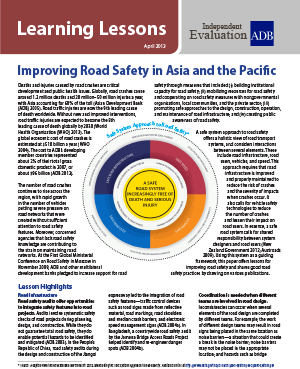Learning Lessons: Improving Road Safety in Asia and the Pacific

Deaths and injuries caused by road crashes are critical development and public health issues. Globally, road crashes cause around 1.2 million deaths and 20 million-50 million injuries a year, with Asia accounting for 60% of the toll (ADB 2005). Road traffic injuries are now the 9th leading cause of death worldwide. Without new and improved interventions, road traffic injuries are expected to become the 5th leading cause of death globally by 2030 (WHO 2013). The global economic cost of road crashes is estimated at $518 billion a year (WHO 2004). The cost to ADB's developing member countries represented about 2% of their total gross domestic product in 2007, or about $96 billion (ADB 2012).
The number of road crashes continues to rise across the region, with rapid growth in the number of vehicles putting severe pressure on road networks that were created without sufficient attention to road safety features. Moreover, concerned agencies that lack road safety knowledge are contributing to the strain on maintaining road networks. At the First Global Ministerial Conference on Road Safety in Moscow in November 2009, ADB and other multilateral development banks pledged to increase support for road safety through measures that included (i) building institutional capacity for road safety; (ii) mobilizing resources for road safety and cooperating on road safety measures with nongovernmental organizations, local communities, and the private sector; (iii) promoting safe approaches to the design, construction, operation, and maintenance of road infrastructure; and (iv) creating public awareness of road safety.
A safe system approach to road safety offers a holistic view of road transport systems, and considers interactions between several elements. These include road infrastructure, road users, vehicles, and speed. This approach requires that road infrastructure is improved and properly maintained to reduce the risk of crashes and the severity of impacts when crashes occur. It also calls for vehicle safety technologies to reduce the number of crashes and lessen their impact on road users. In essence, a safe road system calls for shared responsibility between system designers and road users (New Zealand Government 2012; Austroads 2009). Using this system as a guiding framework, this paper offers lessons for improving road safety and shares good road safety practices by drawing on various publications.